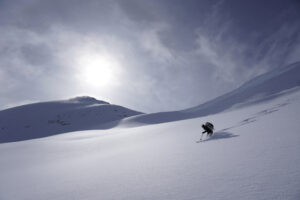
People & Culture
Kahkiihtwaam ee-pee-kiiweehtataahk: Bringing it back home again
The story of how a critically endangered Indigenous language can be saved
- 6310 words
- 26 minutes
This article is over 5 years old and may contain outdated information.
People & Culture


The New Land 2013 expedition is following the route of Norwegian explorer Otto Sverdrup across Ellesmere Island, Nunavut. This blog was written by Toby Thorleifsson.
We are now about midway across the big Nansen Sound, and we are camping directly on the sea ice tonight. Let me tell you a little bit about the sea ice we’ve spent so much time on up here.


Sea ice can be roughly divided into two types: yearly ice, that is ice from the current winter, and multiyear ice, that is ice that can be anywhere from about two to six, seven or even eight years old. A lot of the ice that we’ve travelled on so far on this trip has been yearly ice, or ice from this year.
In the fjords and sounds of Ellesmere Island, the ice is almost flat like the ice on a lake in the interior in the winter. The multiyear ice, on the other hand, is a lot thicker and a bit wavy. It also has small valleys that are remnants of meltdowns from the year before.

Now, when we’re on the sea ice, obviously we need to drink, and we usually have two options for getting water: one is to collect snow that is in drifts on the ice, and the other is to find old sea ice that we can chop the top layer off of and melt. The old sea ice is beautiful; it’s full of air, and it’s a very effective way for us to get water.
One of the big changes on the polar ocean and in the Arctic over the past 20 years is that the multiyear ice, this old generational sea ice, has been very, very much reduced. So about two-thirds of this old ice has disappeared since around 1980, with obvious consequences.
We are now on our way to Axel Heiberg Island, a Norwegian island. On a side note, John’s beard is getting even longer. We’re all still very happy about that and impressed about the progress. Okay, that’s all from ice today.
This blog was originally published on forwardendeavors.com. Read more blog posts from New Land 2013.
Are you passionate about Canadian geography?
You can support Canadian Geographic in 3 ways:

People & Culture
The story of how a critically endangered Indigenous language can be saved

Exploration
A behind-the-scenes look at the adventures and discoveries of the passionate explorers funded by the Royal Canadian Geographical Society

People & Culture
For generations, hunting, and the deep connection to the land it creates, has been a mainstay of Inuit culture. As the coastline changes rapidly—reshaping the marine landscape and jeopardizing the hunt—Inuit youth are charting ways to preserve the hunt, and their identity.

People & Culture
As the climate heats up, so do talks over land ownership in the Arctic. What does Canadian Arctic Sovereignty look like as the ice melts?